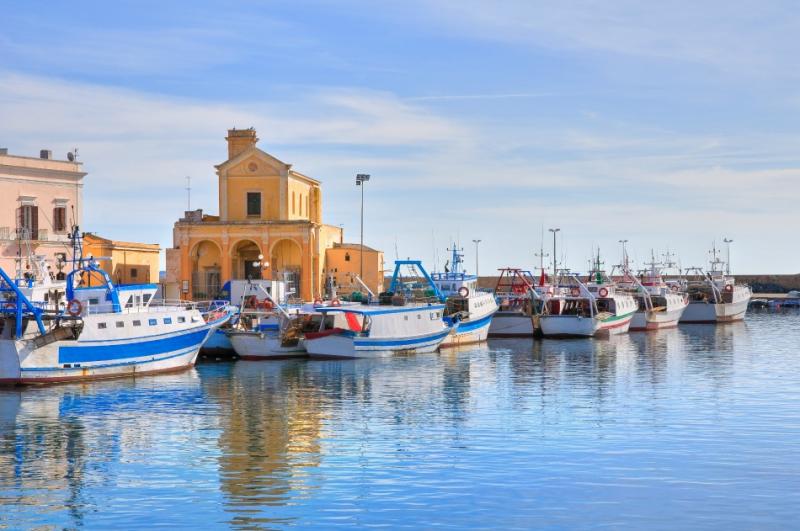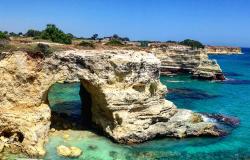Situated south of the main town of Lecce, Salento is an area which more or less comprises the Province of Lecce at the most southerly tip of the Puglia peninsula.
Into the Unknown
An evening fight from Stanstead in late June sets us down in Brindisi at nine pm (local time). Full of anticipation for our imminent three-day adventure and concentrating hard on driving on the ‘wrong’ side, we head south toward the village of Spongano. Being fairly near the centre of the region, Spongano is an ideal base for exploring the countryside but has the added attraction of being just a short hop (about 6km) to the coast.
Our apartment is an oasis of calm. Situated within a medieval walled castle, the Palazzo Bacile occupies a central position in this traditional Salentine village whose history allegedly began with those who escaped the destruction of the nearby coastal town of Castro – the name Spongano deriving from the Latin ‘spolium’ (driven out).
The Coast
Outside our shuttered windows the clear blue skies promise temperatures of around 280C, and surrounded by the scent of blossom, lemon groves and fresh coffee we sketch out our first day’s intended route.
We decide to head north-east toward Otranto, striking the coast at Porto Badisco, then turn south along the winding, craggy coastline toward the very tip of the heel at Santa Maria di Leuca. We pass through countryside criss-crossed with characteristic dry-stone walls, the vegetation wilting under the ever-present threat of drought. The landscape, dotted with farming communities, has been inhabited since ancient times, with remains of Messapian walls, dolmens and menhirs (mysterious megali-thic burial tombs and monuments) rising up among the olive groves. Coming across the shimmering azure sea, with breathtaking craggy scenery and a gaggle of Italian weekend trippers at Porto Badisco, we truly feel ‘Now I’m On Holiday and Want To Spend Time Here’.
We pass through countryside criss-crossed with characteristic dry-stone walls, the vegetation wilting under the ever-present threat of drought. The landscape, dotted with farming communities, has been inhabited since ancient times, with remains of Messapian walls, dolmens and menhirs (mysterious megali-thic burial tombs and monuments) rising up among the olive groves. Coming across the shimmering azure sea, with breathtaking craggy scenery and a gaggle of Italian weekend trippers at Porto Badisco, we truly feel ‘Now I’m On Holiday and Want To Spend Time Here’.
Porto Badisco
 Legend has it that this is where Aeneas first landed in Italy. There are large underground caves whose chambers are filled with fantastic stalagmite and stalactite formations, typical of this coastline, including the unique ‘Grotta dei Cervi’ (Cave of the Deer – whose location is secret), vast caverns discovered in 1990 containing Europe’s most significant complex of Neolithic paintings.
Legend has it that this is where Aeneas first landed in Italy. There are large underground caves whose chambers are filled with fantastic stalagmite and stalactite formations, typical of this coastline, including the unique ‘Grotta dei Cervi’ (Cave of the Deer – whose location is secret), vast caverns discovered in 1990 containing Europe’s most significant complex of Neolithic paintings.
Following the coast road with its sheer cliffs and vistas of clear turquoise waters, we continue through the spa town of Santa Cesarea Terme, where hot sodio-ionic and sulphurous waters emerge from cavities in the rock, and then onward via Castro, situated on one of the most stunning bays of the whole coast, to the southern tip of the peninsula.
Along the way are many coastal defences – from fortified farmhouses to cylindrical signal towers – reminders of how the local people defended their shores against the invading Turks.
Land’s End
At its southernmost tip a cliff stretches out to sea to form the Punta Meliso – a place of such beauty that St Peter reputedly wished that all good Christians should come here at least once in their lives on earth, or failing this, as saints!
The Baroque Sanctuary of Santa Maria di Leuca stands resplendent in honey-coloured stone, having repeatedly suffered destruction, again at the hands of marauding Turks. Below is the pretty marina and town of Leuca (from the Greek, meaning ‘white’), with a variety of architectural styles, including Moorish, Pompeian and Art Nouveau influences, the latter reflecting the fact that this area was already a tourist destination in the early 20th century. With an exceptionally mild climate and bathing season extending well into October, it is easy to see why.
A boat trip is a must here, not only to experience the swell where Ionian and Adriatic seas meet, but also to swim amongst concealed caverns where emerald underwater light suffuses upward.
After witnessing a stunning sunset, silhouetting olive groves and vineyards, we return to Spongano to be warmly invited to take a table at a local trattoria in the main piazza where guests are still arriving to eat at midnight.
Cross Country
A westerly route out from Spongano leads us across country toward Gallipoli, taking in the rural towns of Supersano and Casarano (considered the principal town in this part of western Salento).
The surrounding inland area offers splendid views not only of familiar vineyards and olive groves but also of tobacco fields. Nestling amongst the rolling hills, the towns are typically rural in character and most exhibit interesting medieval remains and Baroque architecture.
However, it is Gallipoli with its perfectly preserved old town, occupying an island, that makes the visit worthwhile. With its white terraced-roof houses, narrow streets and Baroque buildings standing in quiet squares, the old town has a very private feel about it and deserves the Greek appellation ‘kalè polis’ or beautiful city. (See pages 20-24).
Back to Brindisi
 This is the day we have to return to Brindisi airport, but as it’s a nine-thirty pm flight there’s still time to take in Galatina and the provincial capital, Lecce.
This is the day we have to return to Brindisi airport, but as it’s a nine-thirty pm flight there’s still time to take in Galatina and the provincial capital, Lecce.
Salento’s geographical location means it has been settled by innumerable civilizations, traces of which still remain. Influences from the Balkans, Rome, Byzantium, Greece (there are still Greek-speaking villages to this day), Normandy, Surasia, France and Spain through the centuries have resulted in myriad different races and cultures, each contributing to a rich and varied religious tradition which fuses aspects of religion and magic, Christianity and paganism, ancient and modern.
Just one colourful example is an ancient ritual still seen today in Galatina, a busy town originally founded by Byzantine settlers. Over the San Paolo feast days (28th-30th June) those who believe they have been bitten by the tarantula – a symbol of evil – go on a pilgrimage to Galatina. The bite induces a mortal languor which they hope to drive away by non-stop, vigorous dancing (sometimes for days on end!), accompanied by heavily rhythmic music. This ‘Tarantism’ is at the root of today’s ‘Tarantella’.
We then head north to our final destination, Lecce. The city dates from the Messapian civilization (4th century BC) whilst the modern city showcases Baroque architecture at its most sumptuous with numerous finely-detailed churches, castles, amphitheatre and piazzas resonating with the gleam of the chalky-cream Leucchese stone.
This memorable trip is very ‘do-able’ as a short break, whetting the appetite for perhaps a longer visit to fully explore Lecce a gem, amongst so many others ,within this casket of riches that is Salento.
More information about Puglia
*Chek out our Travel to Puglia Guide
*Our feature about Lecce
*More news about Puglia
*The weather in Puglia
*Map of Puglia



